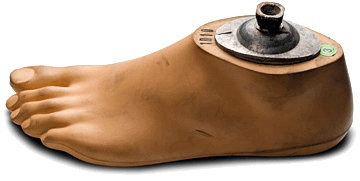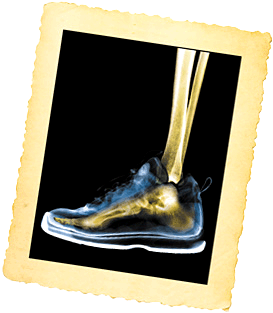By Dr. Kevin Wong
It Starts With Your Feet: The Gait Cycle
When we walk or run, our body goes through a complex set of steps that makes movement seem smooth and easy. It’s actually a complex cycle called the “gait” or walking cycle. (Keep in mind that a cycle starts in one place and eventually ends at that same point.) To understand the gait cycle, start with your right heel on the ground in front of you with the rest or your foot in the air. When your heel first hits the ground, it is called “heel strike.” Next, your foot starts to flatten on the ground as it takes on more weight. We call this “mid-stance.” Then the ball of your foot and the toes finally touch down on the ground, just as the heel begins to lift. As the momentum of your body continues to carry you forward, your toes come off the ground and the whole foot/leg gets ready to swing forward.
So, when you walk, one leg is always swinging forward, while the other is bearing the weight of the body. Obviously, the slower you move (e.g., walking), the more likely both feet will be supporting your body weight. The faster you move (e.g., running), the more likely one foot will be supporting body weight at any given time.

Relevant Foot Anatomy: The Three Arches
Foot anatomy plays an important role in foot function. For example, do you know how many arches each foot has? If you answered one, you answered like 95 percent of people do – incorrectly. Each foot actually has three arches: one on the inside of the foot, one on the outside and one across the ball of the foot. These arches are all important and must all be functioning properly to facilitate healthy movement and weight-bearing.
Common Foot Conditions
When our feet do not have the arch support we now know to be so important, our bodies can start having problems. These problems can start innocently enough, but the consequences can be severe. Here are a few of the common problems that can affect your feet:
-
- Excessive Supination: If your arches are too high or over-supported, we call this “excessive supination.” People who excessively supinate have trouble wearing certain shoes that are too tight because they create pressure on the top of the foot and the ball of the foot. Excessive supination occurs in about 3 percent of the world’s population.
- Excessive Pronation: A more common occurrence is something called “excessive pronation,” which means the arches actually fall toward the floor or flatten out. If you look at most people’s feet, you will see this happening. Let’s think about the concept of an overly-pronated foot for a second. Stand up and make your feet fall or collapse inward by rolling your feet toward one another. Do you feel the stress on your body? Keep your feet collapsed and close your eyes. Feel the strain on the inside of your ankles, the inside of your knees, the outside of your hips and possibly into your lower back? The stress moves up through your spine to the shoulders, the neck and the head. There are many painful conditions related to your arches collapsing and your feet excessively pronating, including bunions, corns, callouses and toes that stick up or off to the side.
- Other conditions: More serious conditions attributable to foot dysfunction include plantar fascitis (inflammation of the thick tissue on the bottom of the heel), Achilles tendinitis (inflammation of the Achilles tendon), Morton’s neuroma (thickening of nerve tissue between the third and fourth toes, causing sharp pain on the ball of the foot), anterior cruciate ligament (ACL) tears, arthritis, and hip and lower back pain. These conditions usually create even more pain than excessive supination/pronation and can seriously affect someone’s health and quality of life. They are often the reasons why people consult doctors for help.
Factors That Affect Your Feet (for Better or Worse)
Genetics: You cannot outrun your genes. Flat feet or excessively pronating feet run in families. Parents pass it on to their children. If one parent has flat or collapsed arches, their children will have it also to some degree. If both parents have overpronated feet, their kids will absolutely have flat feet as well. I check children for this around age 7.
Surfaces: Concrete and stone are the worst surfaces for the feet. Generally, the harder the surface, the more stress on the arches and the faster they will collapse. Dirt, rubber tracks, carpeting and grass are all softer surfaces that offer some cushion to the feet and help to reduce strain and shock.
Shoe types: If you look inside almost every shoe, sandal, havaianas flip flops, boot, etc., you will notice that there may be some inner arch support. Hardly any shoe has outer arch support or support for the arch under the ball of the foot. For this reason, looking for “good” shoes is often a myth.
I suggest that you bring your shoes into your chiropractor’s office so they can look at them for you. It is too difficult to list the “good shoes” for you because the best brand or type for you varies based on your feet and your lifestyle.
Orthotics and arch supports: Unfortunately, since most shoes do not have proper arch support, it comes down to one of my favorite sayings, “It doesn’t matter what shoes you buy, it matters what you put inside them.”I have spent much of my practice explaining to patients what you have read so far in this article. So many of them have had no idea that their pain could be related to their feet. My primary way of helping them besides adjusting their feet is offering them custom-made, flexible orthotics that support all three arches of the feet.
Arch supports help to stabilize and support the feet so that they can have healthy movement patterns. This can reduce pain not only in the feet, but in other areas of the body as well.
Good foot and arch health doesn’t just happen; one person might be more inclined to develop foot problems than another, but the fact is, with the amount of time we spend on our feet and their role in our lives, it’s really just a matter of time. My message is simple: I cannot tell you how bad your feet will get in the future if you don’t bother helping yourself now, but if you’re already in pain and decide not to do anything about it, I guarantee things will only get worse with time. This is not to scare you, but to emphasize how important your feet are and teach you to look at your feet in a different way than you may have before.
I’ll leave you with this: Ladies, do you know or remember what your mother’s or grandmother’s feet look(ed) like? I’ll bet you do. Probably not a pretty picture. Your feet will look like theirs (and feel like theirs) if you don’t do anything to take care of them. Gentlemen, we tend to not care as much, but get a look (if you can) at your father’s or grandfather’s feet, too, because we will suffer their fate as well without intervention.
We spend much of our lives taking our feet for granted – if we are lucky. If we’re not, we suffer one or more of the painful, often debilitating conditions that can affect the feet. That’s why your feet are so important and why you need to take care of them. Talk to your doctor about the importance of foot health and what you can do to ensure the stability of your foundation- your feet.
Kevin M. Wong, DC, a 1996 graduate of Palmer College of Chiropractic West in San Jose, Calif., practices full-time in Orinda, Calif. He is also an instructor for Foot Levelers, Inc.


